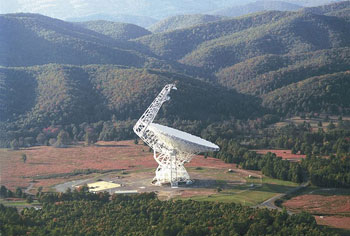That's because Green Bank is home to the world's most sensitive radio telescope, a device that catches the birth and death of stars and signals so faint they are mere whispers from space.

And, since the electronics of mobile phones and Wi-Fi grids would mess with that delicate task, here technology that's taken for granted in much of the world is severely restricted or banned outright.
And a side effect of that radio silence is that Green Bank, population 143, has become a mecca for people who are sick -- literally -- of electromagnetic waves.
They claim the migraines and other ailments they blamed on cell phones go away.
Charles Meckna, 53, is one such refugee. He moved here in July from Nebraska in the Mid-West, fleeing electromagnetic waves he said were making him seriously ill.
For him, the radio telescope is a saviour.
"If we happen to lose the radio telescope, it's done," Meckna said, as he built a shed outside his small home in this town 350km east of Washington, DC.
Green Bank and the area around it in Pocahontas County are in the heart of a so-called "Quiet Zone" declared in 1958 to shield scientists' super-keen eye on the universe.
Standing 150m tall, with a white dish 100m in diameter, the telescope operates day and night capturing signals from space.
"We can look at the birth of stars, the death of stars," said Michael Holstine, business manager at what is formally known as the National Radio Astronomy Laboratory.
"This is the most sensitive radio telescope on the planet," he said.
It can detect a signal that has the equivalent energy to the impact of one snowflake hitting the ground. But to achieve that, the radio environment has to be hush-hush quiet.
A one-of-a-kind "National Radio Quiet Zone" is observed around the telescope over an area of 33,000km². Radio transmissions have to be at a frequency as low as possible.
In a radius of 16km around the telescope, anything that gives off a radio wave - Wi-Fi, cell phones, TV remote controls or microwave ovens -- is banned or restricted.
When you are trying to monitor a quasar, for example -- super-distant, massive celestial objects that give off tremendous amounts of energy -- a cell phone signal is like a loud, bothersome noise, Holstine said.
"A quasar typically gives a signal which is a billionth of a billionth of a billionth of a watt. A cell phone is about two watts," he said.
"It will completely drown out what the astronomers are trying to receive," he added.
The bottom line for non-astronomer earthlings is that dozens of people have come here seeking relief from an ailment called electromagnetic hypersensitivity.
A former construction foreman, Meckna now lives with his wife a few kilometres from the telescope.
He had been sick since the 1990s but took a long time to conclude the culprit was his cell phone.
"I didn't even make the correlation," he said, adding that the beginning of his woes his doctor gave him anti-depressants.
He suffered nausea, migraines and irregular heartbeat every time he got near a Wi-Fi source. After two weeks in Green Bank, the headaches went away.
"I feel much better. I can have a life again," said Meckna.
Still, it is not all gravy. Rather, he feels a bit trapped. "I am a prisoner and I hate it," he said.
Diane Schou, who also suffered after an antenna was set up near her farm in Iowa, said she was essentially forced to come to Green Bank, her home since 2007.
"There is really no choice -- to live here or to live elsewhere and have headaches," said Schou, who is in her 50s.
Her pain was so awful she spent a time living inside a room built by her husband as a sort of "Faraday cage" -- an enclosure built of conductive material, in her case aluminium, that blocks electric fields.
"At least here, I feel I have a future. I can dream what I am going to do. I can invite people over," said Schou.
But she takes care to use any gadgets in her home with the utmost care.
She has a computer, which is hooked up to her landline phone and "very slow." She turns it on a few minutes every day to see emails from her husband, who comes to live with her a few months of the year.
Electromagnetic hypersensitivity, a growing source of concern in a world more connected each day, is not formally classified as a disease by the World Health Organization, although it does acknowledge its existence.
Some studies blame electromagnetic waves but others call it a psychosomatic problem.
The WHO says it plans to carry out a formal assessment in 2016 of the risk posed by the world's billions of cell phones.
Back in Green Bank, at Trent's, a grocery store and gas station, the absence of cell phones is not a worry.
"We've never had cell phones here so I have never missed them," cashier Betty Mullenax said with a chuckle.
Source: AFP, via I-Net Bridge

For more than two decades, I-Net Bridge has been one of South Africa’s preferred electronic providers of innovative solutions, data of the highest calibre, reliable platforms and excellent supporting systems. Our products include workstations, web applications and data feeds packaged with in-depth news and powerful analytical tools empowering clients to make meaningful decisions.
We pride ourselves on our wide variety of in-house skills, encompassing multiple platforms and applications. These skills enable us to not only function as a first class facility, but also design, implement and support all our client needs at a level that confirms I-Net Bridge a leader in its field.
Go to: http://www.inet.co.za